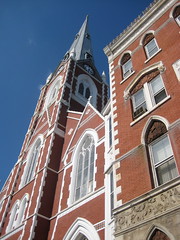From The Peopling of New York City
RELIGION
Poland is a largely Catholic nation, a religion that survived even under the anti-clerical reign of the communists. It is a deeply ingrained part of the Polish life, and thus immigrants to the United States brought the religion with them, Initially, Polish American parishes were established from simple meetings of the local religious in stores or hotels. These meetings soon became societies, taking on the name of a saint, and later developed into the parish itself, with priests arriving from various areas of Poland. The members of the parish were responsible for everything: financial support of their clergy as well as construction of a church and any other buildings needed by the priest. Polish American Catholics were responsible for the creation of seven religious orders, including the Resurrectionists and the Felicians who in turn created schools and seminaries and brought nuns from Poland to help with orphanages and other social services.
Quickly the new arrivals turned their religious institution into both a parish and an okolica, a local area or neighborhood. There was rapid growth in the number of such ethnic parishes: from 17 in 1870 to 512 only 40 years later. The number peaked in 1935 at 800 and has tapered off since, with 760 in 1960. In the 1970s the level of church attendance was beginning to drop off sharply in the Polish American community, and the use of English in the mass was becoming commonplace. However, the newest contingent of Polish refugees has slowed this trend, raising attendance once again, and helping to restore masses in the Polish language at many churches.
All was not smooth for the Polish American Catholics. A largely Protestant nation in the nineteenth century, America proved somewhat intolerant of Catholics, a fact that only served to separate immigrant Poles from the mainstream even more. Also, within the church, there was dissension. Footing all the bills for the parish, still Polish American Catholics had little representation in the hierarchy. Such disputes ultimately led to the establishment of the Polish National Church in 1904. The founding bishop, Reverend Francis Hodur, built the institution to 34 churches and over 28,000 communicants in a dozen years' time.
